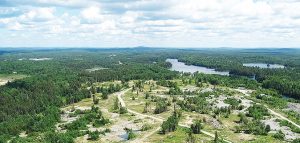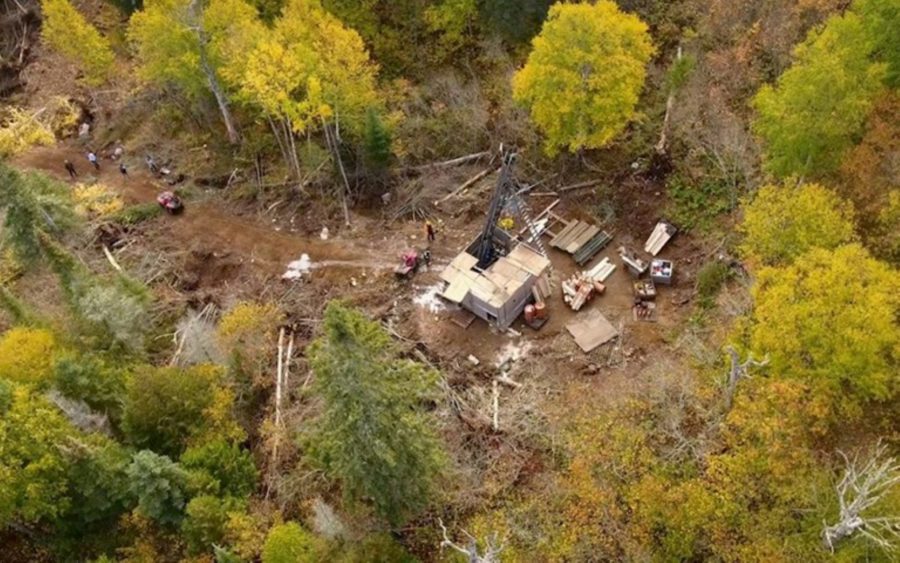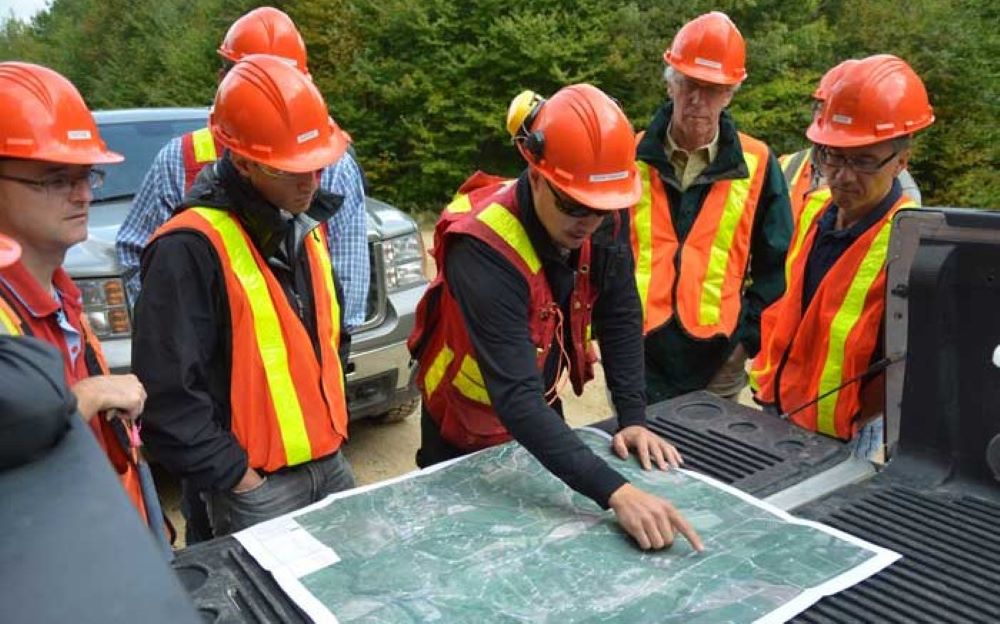Argonaut Gold looks to level up

Magino, 40 km northwest of Wawa, Ont Credit: Argonaut Gold
Argonaut Gold may be known as an open pit, heap-leach gold miner, based on its decade-long history successfully operating several such mines in Mexico.
But the junior miner has been carefully putting in place a strategy to take it to the next level.
Eyeing a transformation from a junior miner with higher-cost, shorter–life assets to an intermediate producer with lower-cost, longer-life, diversified gold operations, Argonaut greenlit construction of its Magino project in Ontario in October.
The project located 40 km northwest of Wawa, Ont., is expected to produce 115,000 oz. of gold per year over a 17-year mine life, and Argonaut believes it has potential for much more.
As it is, Magino will become the junior’s cornerstone asset. For comparison, Argonaut produced more than 186,600 gold-equivalent oz. at its three open-pit heap leach operations in Mexico last year.
While Magino has long been seen as a core asset in Argonaut’s portfolio, the US$360-380 million price tag was a bit too hefty for the junior – until recently.
“A year ago, the biggest question was: ‘How do you move Magino forward?’” said Dan Symons, Argonaut’s vice-president of corporate development and investor relations, in a recent presentation. “Everyone recognized it’s the most strategic asset in our portfolio – it’s in Canada, it’s right next to Alamos Gold’s Island gold mine, it has great infrastructure in place – but the capital commitment of between US$360 and US$380 million – how is a company like Argonaut going to fund that?”
The company provided a partial answer to that question with an at-market acquisition of Alio Gold that was announced in March and closed in July.
The merger brings a new open pit, heap–leach mine into Argonaut’s portfolio, but one that’s located in Nevada and has a longer life than its assets in Mexico. The mine, Florida Canyon, will also replace production from Argonaut’s El Castillo mine, slated to close in 2022.
Florida Canyon and Argonaut’s other operations are expected to generate cash flow of at least US$142 million through 2022, assuming gold stays at or above US$1,600 per oz. Combined with the company’s existing cash balance of US$172 million (including a bought–deal equity raise of $126.5 million that closed in July), that will go a long way to paying the tab for Magino.
To fill the gaps, Argonaut closed a US$57.5-million offering of senior unsecured convertible debentures in October. And before the end of the year, it expects to close a US$30-million sale of a non-core asset – Ana Paula, in Guerrero, Mexico, which was part of the Alio portfolio.
In total, that’s more than US$400 million available for Magino.
Lastly, as a safety net, Argonaut recently expanded its revolving credit facility to US$125 million from US$75 million.
In addition to the financing, other critical elements of the project have also come together in the past year – permitting (including its Schedule 2 federal permit this year), First Nations agreements (the company signed impact benefit agreements with five groups in March) and detailed engineering.
“Where we were a year ago to where we are today – it’s night and day,” said president and CEO Peter Dougherty in an interview in late October. “It’s amazing what a year can do.”
Ambitious plans
With a global pandemic raging, it’s undoubtedly a tricky time to execute on an amibitous transformation plan. The biggest damper Covid-19 has placed on the mining sector is a drag on M&A – despite a strong gold price and the recognition that more consolidation is necessary.
Pre-pandemic consolidations of big players such as Barrick Gold and Randgold and Newmont and Goldcorp were signs that, as Dougherty puts it, gold investors had “too many items to order off the menu.”
With the same pressures on smaller gold miners, Argonaut struck a friendly deal with cash-strapped Alio.
“For us, this is great,” said Dougherty. “It’s diversification into the U.S., Florida Canyon will be the longest life of our current projects – and it probably also has greatest exploration upside of our currrent operations, too.”
Florida Canyon is currently a high-cost mine, but with a modest capital investment, the company believes it can lower operating costs at the project by 50-60¢ per ton (they were $1.41 in the first quarter of 2020). In addition to new leach pad construction at Florida Canyon, Argonaut is investing $10 million on a modifications to the crushing and stacking circuit to reduce ore handling at the operation. Those modifications should be in place in the first quarter of next year.
An updated life of mine plan for Florida Canyon that Argonaut released in July outlined a 9.5-year mine life with average annual production of 77,000 oz. gold at all-in sustaining costs of US$1,040 per oz.
The project also contains the past-producing Standard mine. Both Florida Canyon and Standard have been underexplored, Dougherty says, with no real systematic drilling since the 1990s.
To remedy that, Argonaut is conducting a 10,000 ft. drill program this year, with 75,000 ft. planned in 2021.
With Florida Canyon in the mix, Argonaut has updated its 2020 guidance to 210,000 to 230,000 gold-equivalent oz. at all-in sustaining costs (AISC) of US$1,225 to US$1,350 per oz.
Tier 1 potential
Meanwhile, construction at Magino, is slated to begin in January, with first gold expected in the first half of 2023.
While the open pit mine will initially be built as a 10,000 t/d operation, Argonaut is permitting it for 35,000 t/d.
As it is, the mine, which is expected to produce 150,000 oz. gold per year in its first five years at an AISC of US$711 per oz., according to a 2017 feasibility study, will be transformational for a company of Argonaut’s size.
But based on encouraging drilling results at depth under the planned pit, and the fact that similar Archean gold projects – including Alamos Gold’s Island mine next door – tend to increase in grade at depth and host very long life mines, the company believes the project has potential to become a Tier 1 asset producing 300,000 oz. gold per year.
“We think that there’s a 20,000–tonne–per-day case for 20 years, producing 300,000 oz. a year. That’s really where our hopes and dreams lie,” Dougherty says. “Then you don’t have an asset that is just cornerstone meaningful to us – I don’t care who you are in this business, that’s an asset you want to have in your portfolio.”
Studies are underway looking at the potential to add an underground mining component to Magino and to double throughput to 20,000 t/d. A maiden underground resource is expected by the end of the year and drilling is ongoing to upgrade existing resources.
At a gold price of US$1,200 per oz., Magino holds proven and probable reserves of 2.1 million oz. gold in 58.9 million tonnes grading 1.13 g/t gold. Current measured and indicated resources (inclusive of reserves) stand at 4.2 million oz. gold in 144 million tonnes grading 0.91 g/t gold. Inferred resources add 886,000 oz. in 33.2 million tonnes at 0.83 g/t.
Flexibility
While Magino would most certainly be Argonaut’s flagship operation, it’s not the only development project the junior is advancing.
The company’s Cerro del Gallo project, in Guanajuato, Mexico, is currently in the permitting stage. Although it’s another open pit heap–leach mine, the US$134-million project boasts a long life of 15.5 years with production of 1.2 million gold-equivalent oz. per year at an AISC of US$677 per oz.
With permits expected sometime between late 2020 and mid-2021, Dougherty says Argonaut realized it wouldn’t have the bandwidth to build both it and Magino at the same time while also conducting a large drill program at Florida Canyon.
For that reason, Argonaut has opted for an EPC contract for development of Magino – a type of agreement where the contractor takes responsibility for more of the project, from design to procurement and construction – rather than an EPCM (engineering, procurement and construction management) contract.
“We realized if we’re going to have success in all of those regions, we need to have greater potential flexibility,” Dougherty said. “So we went out and partnered with Ausensco Group – they’re the ones who built the Moose River project (now owned by St Barbara) – and they will be helping us adminster and build the Magino project. They will be doing the heavy lifting, 80% of it is going to be on their shoulders.”
While Dougherty concedes EPC contracts tend to be more expensive, he says they also take some of the uncertainty out of the process as the contractor comes up with a fixed price for the client to pay. Not only does it ensure the project is in the hands of experts in project deliverywho have the necessary teams and contacts to get it done efficiently, but the fact that the contractor shares the risk is attractive. “They put their balance sheet at risk with an EPC–type contract, it’s not your balance sheet at risk,” he says.
Dougherty says the company began working with Ausenco last September on the details.
“We spent well over a year working on this contract, defining I want this motor, I want this type of lining in the pipe, and defining how this is going to look,” he says. “This is the kind of level you need to go to and time you need to spend (with an EPC contract) – otherwise you could get caught by surprise later on.”
So far, the company has received a fixed–bid pricing proposal that covers 50% of Magino’s expected initial capital cost of US$360-380 million.
As it stands, because Magino will be one of the first projects built early in this new cycle of rising gold prices, Dougherty says it will enjoy the “first mover advantage” of better pricing and access to the best teams.
“I’m really pleased with where we are today,” Dougherty concludes. “It’s very fortuitous that we’re in the timing that we are. The gold market is starting to heat up, people are talking about production and growth within this business, and we happen to be one of the lucky ones.”





Comments